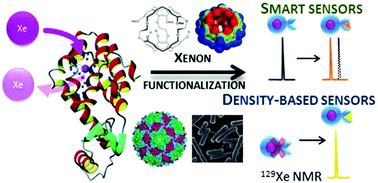Our official English website, www.x-mol.net, welcomes your
feedback! (Note: you will need to create a separate account there.)
129Xe NMR-based sensors: biological applications and recent methods
Analyst ( IF 3.6 ) Pub Date : 2017-08-08 00:00:00 , DOI: 10.1039/c7an01088e E. Mari 1, 2, 3, 4, 5 , P. Berthault 1, 2, 3, 4, 5
Analyst ( IF 3.6 ) Pub Date : 2017-08-08 00:00:00 , DOI: 10.1039/c7an01088e E. Mari 1, 2, 3, 4, 5 , P. Berthault 1, 2, 3, 4, 5
Affiliation

|
Xenon is a first-rate sensor of biological events owing to its large polarizable electron cloud, which induces significant modifications to NMR parameters in response to slight changes in its local environment. The use of xenon as a sensor is of increasing interest for sensitive magnetic resonance imaging, because its signal can be enhanced by several orders of magnitude, mainly by spin-exchange optical pumping. Furthermore, xenon can be vectorized toward targets of interest by using functionalized host systems, which enables their detection at sub-nanomolar concentrations. In association with a new generation of detection methods, this gives rise to a powerful molecular imaging approach, whereby xenon can be delivered systematically several times after the introduction of a functionalized host system.
中文翻译:

129基于Xe NMR的传感器:生物学应用和最新方法
氙由于其较大的可极化电子云而成为生物事件的一流传感器,它响应于其局部环境的微小变化而引起NMR参数的显着改变。使用氙气作为传感器对于敏感的磁共振成像越来越重要,因为它的信号可以增强几个数量级,主要是通过自旋交换光泵浦。此外,可以通过使用功能化的宿主系统将氙气定向到目标靶标,从而可以在亚纳摩尔浓度下检测它们。与新一代的检测方法相结合,这产生了一种功能强大的分子成像方法,通过这种方法,可以在引入功能化宿主系统后系统地多次递送氙气。
更新日期:2017-09-08
中文翻译:

129基于Xe NMR的传感器:生物学应用和最新方法
氙由于其较大的可极化电子云而成为生物事件的一流传感器,它响应于其局部环境的微小变化而引起NMR参数的显着改变。使用氙气作为传感器对于敏感的磁共振成像越来越重要,因为它的信号可以增强几个数量级,主要是通过自旋交换光泵浦。此外,可以通过使用功能化的宿主系统将氙气定向到目标靶标,从而可以在亚纳摩尔浓度下检测它们。与新一代的检测方法相结合,这产生了一种功能强大的分子成像方法,通过这种方法,可以在引入功能化宿主系统后系统地多次递送氙气。











































 京公网安备 11010802027423号
京公网安备 11010802027423号